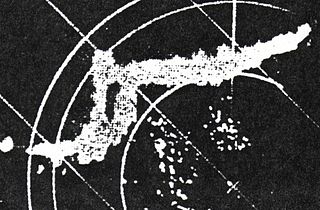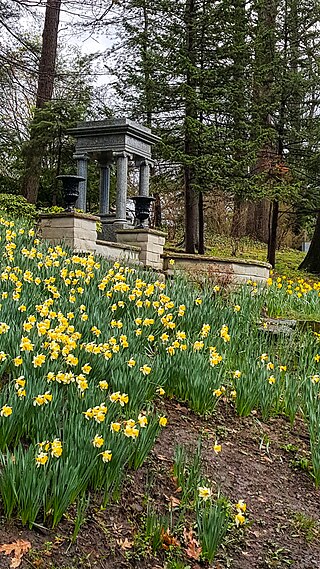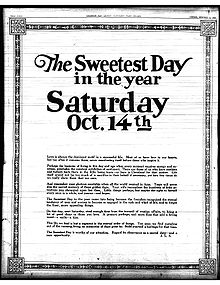
Cleveland is a city in the U.S. state of Ohio and the county seat of Cuyahoga County. Located along the southern shore of Lake Erie, it is situated across the Canada–United States maritime border and lies approximately 60 mi (97 km) west of Pennsylvania. Cleveland is the most populous city on Lake Erie, the second-most populous city in Ohio, and the 54th-most populous city in the U.S. with a population of 372,624 in 2020. The city anchors the Cleveland metropolitan area, the 33rd-largest in the U.S. at 2.18 million residents, as well as the larger Cleveland–Akron–Canton combined statistical area with 3.63 million residents.

Trick-or-treating is a traditional Halloween custom for children and adults in some countries. During the evening of Halloween, on October 31, people in costumes travel from house to house, asking for treats with the phrase "trick or treat". The "treat" is some form of confectionery, usually candy/sweets, although in some cultures money is given instead. The "trick" refers to a threat, usually idle, to perform mischief on the resident(s) or their property if no treat is given. Some people signal that they are willing to hand out treats by putting up Halloween decorations outside their doors; houses may also leave their porch lights on as a universal indicator that they have candy; some simply leave treats available on their porches for the children to take freely, on the honor system.

George Victor Voinovich was an American politician who served as a United States senator from Ohio from 1999 to 2011. He previously served as the 65th governor of Ohio from 1991 to 1998 and as the 54th mayor of Cleveland from 1980 to 1989, the last Republican to serve in that office.

In the United States, public holidays are set by federal, state, and local governments and are often observed by closing government offices or giving government employees paid time off. The federal government does not require private businesses to close or offer paid time off, as is the case for most state and local governments, so employers determine which holidays to observe.
American Greetings Corporation is a privately held American company and is the world's second largest greeting card producer behind Hallmark Cards. Based in Westlake, Ohio, a suburb of Cleveland, the company sells paper greeting cards, electronic greeting cards, gift packaging, stickers and party products. In addition, the company owns the Carlton Cards, Tender Thoughts, Papyrus, Recycled Paper Greetings and Gibson brands.

Balto was an Alaskan husky and sled dog belonging to musher and breeder Leonhard Seppala. He achieved fame when he led a team of sled dogs driven by Gunnar Kaasen on the final leg of the 1925 serum run to Nome, in which diphtheria antitoxin was transported from Anchorage, Alaska, to Nenana, Alaska, by train and then to Nome by dog sled to combat an outbreak of the disease. Balto's celebrity status, and that of Kaasen's, resulted in a two-reel motion picture, a statue in Central Park, and a nationwide tour on the vaudeville circuit.

Terminal Tower is a 52-story, 708 ft (216 m), landmark skyscraper located on Public Square in the downtown core of Cleveland, Ohio, United States. Built during the skyscraper boom of the 1920s and 1930s, it was the second-tallest building in the world when it was completed. Terminal Tower stood as the tallest building in North America outside of New York City from its completion in 1927 until 1964. It was the tallest building in the state of Ohio until the completion of Key Tower in 1991, and remains the second-tallest building in the state. The building is part of the Tower City Center mixed-use development, and its major tenants include Forest City Enterprises, which maintained its corporate headquarters there until 2018, and Riverside Company.

WHK is a commercial AM radio station licensed to Cleveland, Ohio, carrying a talk format known as "AM 1420 The Answer". Owned by the Salem Media Group, the station serves both Greater Cleveland and the Northeast Ohio region as an affiliate for the Salem Radio Network. WHK's studios are currently located in the Cleveland suburb of Independence while the transmitter site resides in neighboring Seven Hills.
In the United States, a Hallmark holiday is a holiday that is perceived to exist primarily for commercial purposes rather than to commemorate a traditionally or historically significant event.
Cecil B. Leeson, was an American musician and teacher who was widely credited with establishing the saxophone as a legitimate concert instrument in the U.S.
The Cleveland crime family, also known as the Scalish crime family or the Cleveland Mafia, is an Italian-American Mafia crime family based in Cleveland, Ohio, and throughout the Greater Cleveland area. The organization formed during the 1900s, and early leadership turned over frequently due to a series of power grabs and assassinations. In 1930, Frank Milano became boss and was able to bring some stability to the Cleveland family. Under the control of the family's longest-serving boss, John T. Scalish, who led the organization from 1945 until his death in 1976, the Cleveland family exerted influence over the International Brotherhood of Teamsters (IBT), profiting from labor racketeering and the skimming of revenue from Las Vegas casinos. The family's membership peaked at around sixty "made men" during the 1950s.
William A. Feather was an American publisher and writer, based in Cleveland, Ohio.

The Ohio Fireworks Derecho, was a severe wind event that took place during the evening hours of July 4 1969. It affected the northern half of the state of Ohio as well as portions of Pennsylvania, southern Michigan, northern West Virginia and extreme southwestern New York. It was one of the numerous events of that type that hit a region in the United States during its national holiday, the others being in 1977, 1980, and 1999.

Alfred Polizzi was a Sicilian emigrant to the United States who was boss of the Cleveland crime family in Cleveland, Ohio, from 1935 to 1945. He stabilized the Cleveland crime family after a period of revenge killings, and was one of the most influential mobsters in the United States. He retired to Florida in 1945, where he was involved in the construction industry. He used several aliases, including "Big Al" and Albert Allen.

Smarties Candy Company is a confectionery company well known for its namesake candy, Smarties. Edward "Eddie" Dee founded Ce De Candy in Bloomfield, New Jersey, in 1949. Dee emigrated from England to the United States.

Hallmark Cards, Inc. is a privately held, family-owned American company based in Kansas City, Missouri. Founded in 1910 by Joyce Hall, Hallmark is one of the oldest and largest manufacturers of greeting cards in the United States. In 1985, the company was awarded the National Medal of Arts.

The James A. Garfield Memorial is the final resting place of assassinated President James A. Garfield, located in Lake View Cemetery in Cleveland, Ohio. The memorial, which began construction in October 1885 and was dedicated on May 30, 1890, exhibits a combination of Byzantine, Gothic, and Romanesque Revival architectural styles. Garfield, former First Lady Lucretia Garfield, and two other members of the Garfield family are entombed in the crypt level of the monument.

Lake View Cemetery is a privately owned, nonprofit garden cemetery located in the cities of Cleveland, Cleveland Heights, and East Cleveland in the U.S. state of Ohio. Founded in 1869, the cemetery was favored by wealthy families during the Gilded Age, and today the cemetery is known for its numerous lavish funerary monuments and mausoleums. The extensive early monument building at Lake View helped give rise to the Little Italy neighborhood, but over-expansion nearly bankrupted the burial ground in 1888. Financial recovery only began in 1893, and took several years. Lake View grew and modernized significantly from 1896 to 1915 under the leadership of president Henry R. Hatch. The cemetery's cautious management allowed it to avoid retrenchment and financial problems during the Great Depression.

World Chocolate Day, or just Chocolate Day, is an annual celebration of chocolate, occurring globally on July 7, which some suggest to be the anniversary of the introduction of chocolate to Europe in 1550. The observance of World Chocolate Day dates back to 2009 and is not to be confused with International Chocolate Day.

The Cleveland and Mahoning Valley Railroad (C&MV) was a shortline railroad operating in the state of Ohio in the United States. Originally known as the Cleveland and Mahoning Railroad (C&M), it was chartered in 1848. Construction of the line began in 1853 and was completed in 1857. After an 1872 merger with two small railroads, the corporate name was changed to "Cleveland and Mahoning Valley Railroad". The railroad leased itself to the Atlantic and Great Western Railway in 1863. The C&MV suffered financial instability, and in 1880 its stock was sold to a company based in London in the United Kingdom. A series of leases and ownership changes left the C&MV in the hands of the Erie Railroad in 1896. The CM&V's corporate identity ended in 1942 after the Erie Railroad completed purchasing the railroad's outstanding stock from the British investors.
















